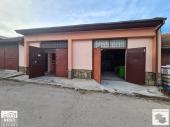|
| History of furniture |
|
|
 Furniture in fashion has been a part of the human experience since the development of non-nomadic cultures. Evidence of furniture survives from the Neolithic Period and later in antiquity in the form of paintings, such as the wall Murals discovered at Pompeii; sculpture, and examples have been excavated in Egypt and found in tombs in Ghiordes, in modern day Turkey.
Furniture in fashion has been a part of the human experience since the development of non-nomadic cultures. Evidence of furniture survives from the Neolithic Period and later in antiquity in the form of paintings, such as the wall Murals discovered at Pompeii; sculpture, and examples have been excavated in Egypt and found in tombs in Ghiordes, in modern day Turkey.
Neolithic Period
A range of unique stone furniture has been excavated in Skara Brae a Neolithic village, located in Orkney. The site dates from 3100–2500 BC and due to a shortage of wood in Orkney, the people of Skara Brae were forced to build with stone, a readily available material that could be worked easily and turned into items for use within the household. Each house shows a high degree of sophistication and was equipped with an extensive assortment of stone furniture, ranging from cupboards, dressers and beds to shelves, stone seats, and limpet tanks. The stone dressers were regarded as the most important as it symbolically faces the entrance in each house and is therefore the first item seen when entering, perhaps displaying symbolic objects, including decorative artwork such as several Neolithic Carved Stone Balls also found at the site.
The Classical World
Early furniture has been excavated from the 8th-century BC Phrygian tumulus, the Midas Mound, in Gordion, Turkey. Pieces found here include tables and inlaid serving stands. There are also surviving works from the 9th-8th-century BC Assyrian palace of Nimrud. The earliest surviving carpet, the Pazyryk Carpet was discovered in a frozen tomb in Siberia and has been dated between the 6th and 3rd century BC. Recovered Ancient Egyptian furniture includes 3rd millennium BC beds discovered at Tarkhan as place for the deceased, a c. 2550 BC gilded bed and to chairs from the tomb of Queen Hetepheres, and many examples (boxes, beds, chairs) from c. 1550 to 1200 BC from Thebes. Ancient Greek furniture design beginning in the 2nd millennium BC, including beds and the klismos chair, is preserved not only by extant works, but by images on Greek vases. The 1738 and 1748 excavations of Herculaneum and Pompeii introduced Roman furniture, preserved in the ashes of the 79 A.D. eruption of Vesuvius, to the eighteenth century.
Early Modern Europe
The furniture of the Middle Ages was usually heavy, oak, and ornamented with carved designs. Along with the other arts, the Italian Renaissance of the fourteenth and fifteenth century marked a rebirth in design, often inspired by the Greco-Roman tradition. A similar explosion of design, and renaissance of culture in general, occurred in Northern Europe, starting in the fifteenth century. The seventeenth century, in both Southern and Northern Europe, was characterized by opulent, often gilded Baroque designs that frequently incorporated a profusion of vegetal and scrolling ornament. Starting in the eighteenth century, furniture designs began to develop more rapidly. Although there were some styles that belonged primarily to one nation, such as Palladianism in Great Britain or Louis Quinze in French furniture, others, such as the Rococo and Neoclassicism were perpetuated throughout Western Europe.
There is in Italy a geographical area named Brianza . Its economy included and includes production of furniture, furnishing from 1748. The most important towns for this economy are in zones near Cantù with Arosio, Cabiate, Inverigo, Mariano Comense and Lissone with Barlassina, Bovisio Masciago, Briosco, Cesano Maderno, Desio, Giussano, Lentate sul Seveso, Limbiate, Macherio, Seregno, Seveso, Verano Brianza; to remember also zone near Renate
19th Century
The nineteenth century is usually defined by concurrent revival styles, including Gothic, Neoclassicism, Rococo, and the EastHaven Movement. The design reforms of the late century introduced the Aesthetic movement and the Arts and Crafts movement. Art Nouveau was influenced by both of these movements.
Source: wikipedia.org
|
| Wednesday, Sep 07, 2011 |
|
|
|
|
| » RENTALS |

|
|
|
| Commercial |
€ 410 |
|
| Location: |
Gorna Oryahovica |
|
|

|